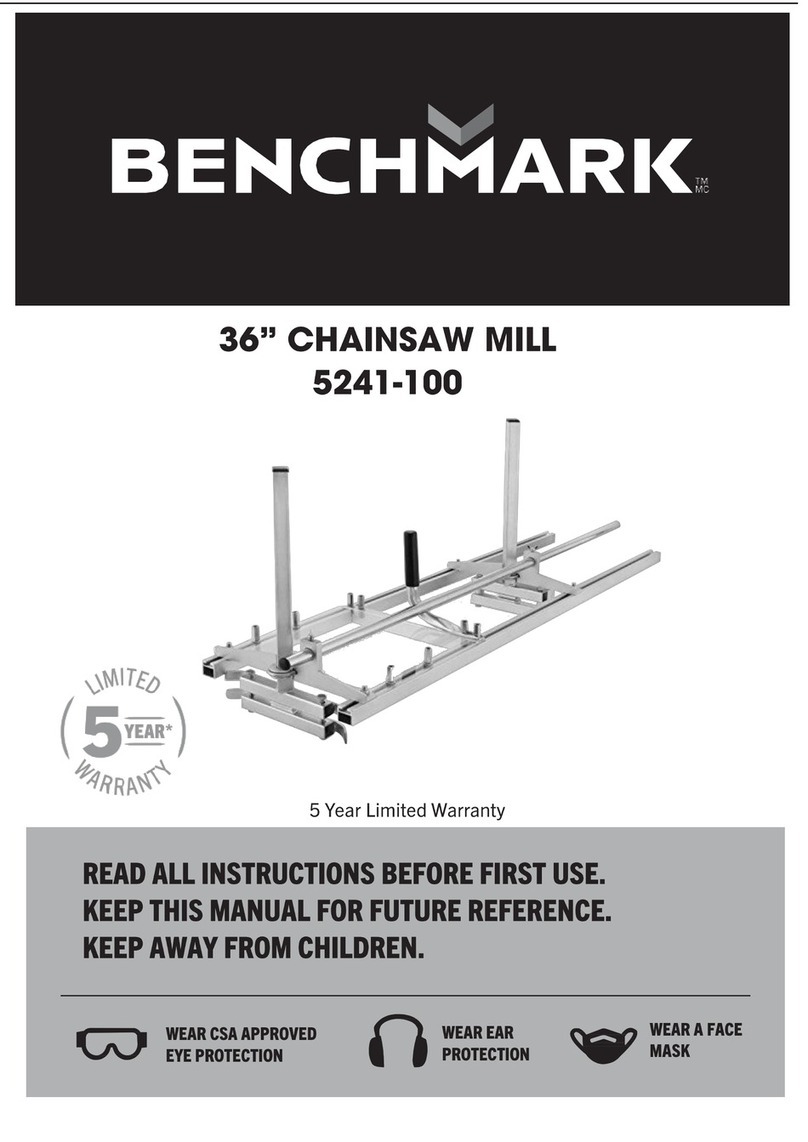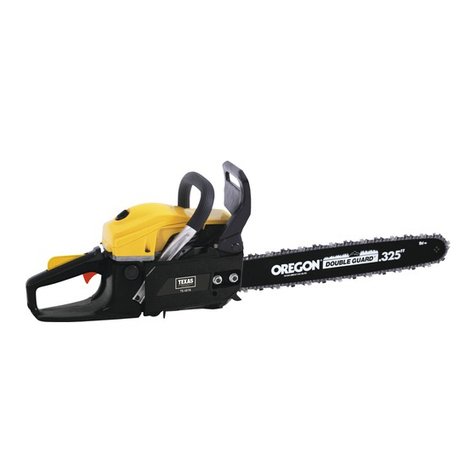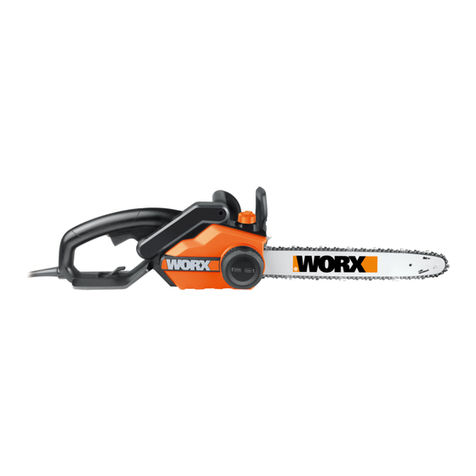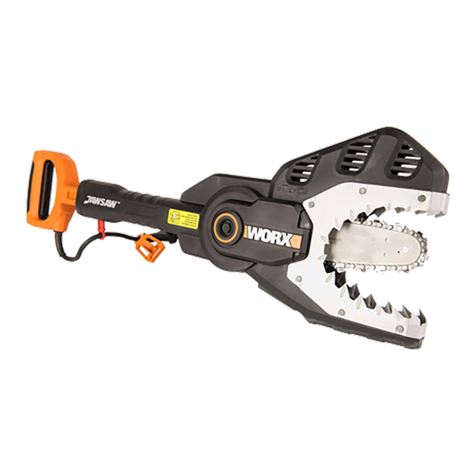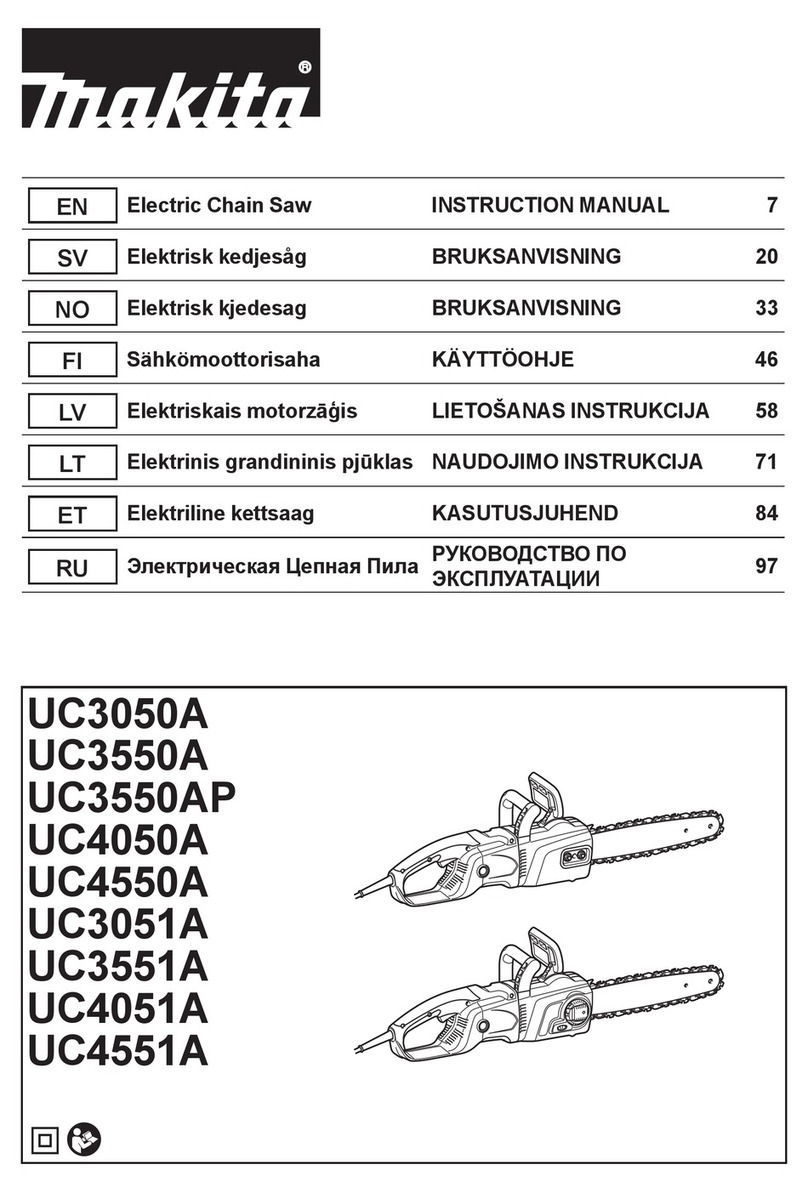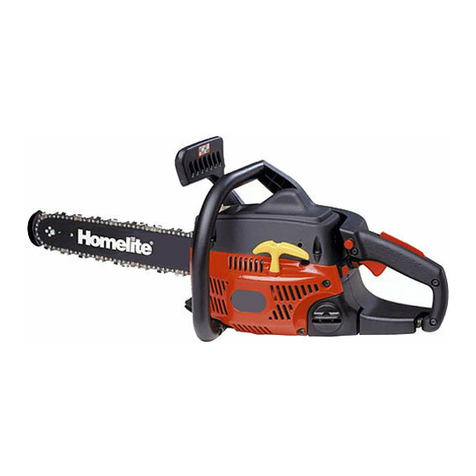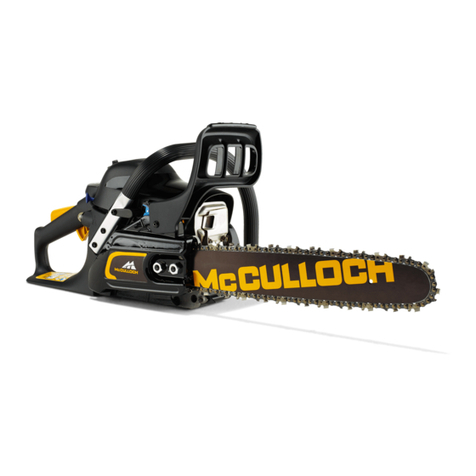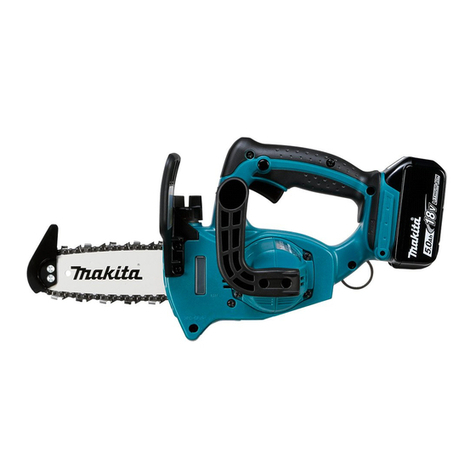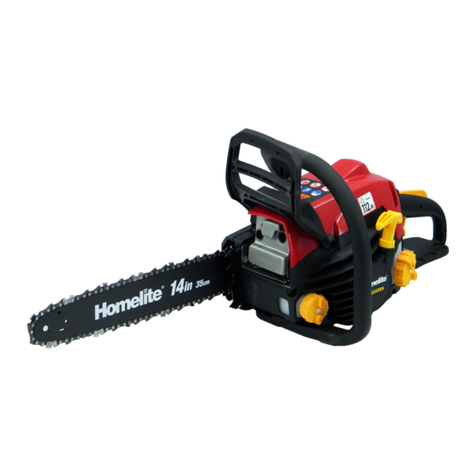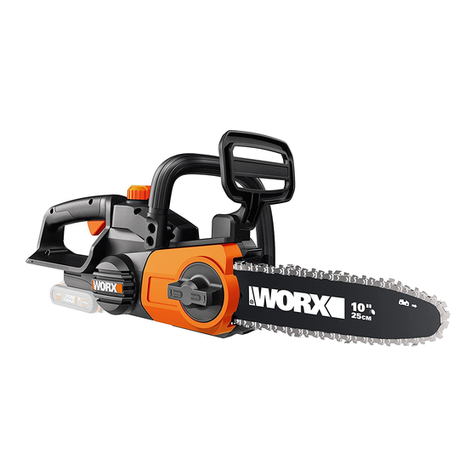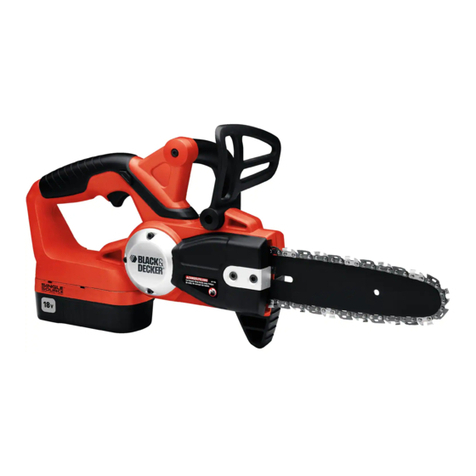Benchmark 5240-050 User manual

60V 16-INCH CORDLESS
CHAINSAW
READ ALL INSTRUCTIONS BEFORE FIRST USE.
KEEP THIS MANUAL FOR FUTURE REFERENCE.
KEEP AWAY FROM CHILDREN.
Maximum initial battery voltage (measured without a load)
is 60 volts. Normal voltage is 54 volts.
WEAR CSA APPROVED
EYE PROTECTION
WEAR EAR
PROTECTION
WEAR A
FACE MASK
5 Year Limited Warranty on tool
3 Year on battery and charger

1
PRODUCT SPECIFICATIONS
60V 16-INCH CORDLESS CHAINSAW
Sku No. 5240-050
Nominal Voltage of 60 v d.c. / 2.5 Ah Li-ion
Chain Speed 33 ft./s
Cutting Length 16 in. (400 mm)
Chain Type Recommended Oregon type 90PX056X
Guide Bar Type Recommended Oregon type 164MLEA041
Weight 17 lbs 17 lbs
Battery Pack Model 5350-018
Battery Capacity 60 V DC, 2.5 Ah
Battery Charger Model 5350-020
Input 100–240 V~, 50/60 Hz, 150 W
Output 63 V d.c., 2.5 A
NEED ASSISTANCE?
Call us on our toll-free customer support line:
1-833-818-4111
• Technical questions
• Replacement parts
• Parts missing from package
BENCHMARK 60V HAND-HELD TOOL HAS A 2-STEP BATTERY LATCH
INSTALLATION: The battery latch has 2
positions. Press down firmly until battery
is fully inserted. If the battery is not fully
inserted and secured in the deepest
position #2 the tool will not run.
REMOVAL: Press the release button
once, the battery will release from the
first latch position. Then hold the battery
firmly, press the release button again
and pull battery out.
Latch #2
Latch #1

2
60V 16-INCH CORDLESS CHAINSAW 5240-050
TABLE OF CONTENTS
Product Specifications................................................................................... 1
Benchmark 60V Hand-held Tool has a 2-Step Battery Latch ........................... 1
Table of Contents .......................................................................................... 2
General Safety Instructions ........................................................................... 4
Eye, Ear & Lung Protection ............................................................................ 4
Safety Symbols ............................................................................................. 5
Safety Instructions ........................................................................................ 5
Power Tool Safety .......................................................................................... 7
Work Area Safety .......................................................................................... 7
Electrical Safety ............................................................................................ 7
Personal Safety ............................................................................................. 7
Power Tool Use and Care ............................................................................... 8
Battery Tool Use and Care ............................................................................. 8
Service ......................................................................................................... 9
Specific Safety Instructions for Chainsaw ...................................................... 9
Causes And Operator Prevention of Kickback .............................................. 10
Kickback Safety Devices on This Chainsaw Chain ........................................ 11
Brake .......................................................................................................... 11
Low Kickback Saw Chain ............................................................................. 12
Guide Bar ................................................................................................... 12
Additional Warnings .................................................................................... 12
Technical Data ............................................................................................ 15
Functions .................................................................................................... 15
Delivery Parts .............................................................................................. 16
Installation .................................................................................................. 16
Install the Guide Bar and Saw Chain ............................................................ 16
Adjusting the Chain Tension ........................................................................ 17
Filling Bar and Chain Lubricant Oil ............................................................... 18
Charging the Battery Pack ........................................................................... 18
Power Indicator ........................................................................................... 19
To Obtain the Best Life From the Battery ..................................................... 19
Inserting and Removing the Battery Pack .................................................... 19
Insert the Battery Pack ................................................................................ 20
Remove the Battery Pack ............................................................................ 20
Starting/Stopping the Chainsaw .................................................................. 20
To Start ....................................................................................................... 21
To Stop ....................................................................................................... 21
Indicator Panel ............................................................................................ 21
Proper Grip on Handles ............................................................................... 22
Proper Cutting Stance ................................................................................. 22
Instructions Concerning the Proper Techniques for Basic Felling,
Limbing, and Cross-Cutting ......................................................................... 22
Felling a Tree .............................................................................................. 22
Latch #2
Latch #1

3
Removing Buttress Roots ............................................................................ 24
Bucking a Log ............................................................................................. 24
Limbing a Tree ............................................................................................ 25
Maintenance and Storage ........................................................................... 26
Cleaning ..................................................................................................... 26
Replacing the Bar and Chain ....................................................................... 26
Disassemble the Worn Bar and Chain .......................................................... 27
Assemble the New Bar and Chain ................................................................ 27
Adjust the Chain Tension ............................................................................. 27
Chain Maintenance ..................................................................................... 27
Guide Bar Maintenance ............................................................................... 28
Transporting and Storing ............................................................................. 28
Troubleshooting........................................................................................... 29
Warranty ..................................................................................................... 29

4
GENERAL SAFETY INSTRUCTIONS
WARNING: Before using this tool or any of its accessories, read this manual
and follow all Safety Rules and Operating Instructions. The important precautions,
safeguards and instructions appearing in this manual are not meant to cover all
possible situations. It must be understood that common sense and caution are
factors which cannot be built into the product.
EYE, EAR & LUNG PROTECTION
SYMBOL MEANING
ALWAYS WEAR EYE PROTECTION THAT CONFORMS
WITH CSA Z94.3 or ANSI SAFETY STANDARD Z87.1
FLYING DEBRIS can cause permanent eye damage.
Prescription eyeglasses ARE NOT a replacement for proper
eye protection. The usage of a safety standard compliant
face shield placed over proper safety glasses or goggles
can reduce the risk of facial injury.
Non-compliant eyewear can cause serious injury if broken
during the operation of a power tool.
Use hearing protection, particularly during extended periods
of operation of the tool, or if the operation is noisy.
WEAR A DUST MASK THAT IS DESIGNED TO BE
USED WHEN OPERATING A POWER TOOL IN A
DUSTY ENVIRONMENT.
Dust that is created by power sanding, sawing, grinding,
drilling, and other construction activities may contain
chemicals that are known to cause cancer, birth defects,
or other genetic abnormalities. These chemicals include:
• Lead from lead-based paints
• Crystalline silica from bricks, cement, and other
masonry products
• Arsenic and chromium from chemically treated lumber
The level of risk from exposure to these chemicals varies,
according to how often this type of work is performed. In
order to reduce exposure to these chemicals, work in a
well-ventilated area, and use approved safety equipment,
such as a dust mask that is specifically designed to filter
out microscopic particles.
5240-050
60V 16-INCH CORDLESS CHAINSAW

5
SAFETY SYMBOLS
The purpose of safety symbols is to attract your attention to possible dangers. The
safety symbols and the explanations with them deserve your careful attention and
understanding. The symbol warnings do not, by themselves, eliminate any danger.
The instructions and warnings they give are no substitutes for proper accident
prevention measures.
WARNING: Be sure to read and understand all safety instructions in this
Operator’s Manual, including all safety alert symbolssuch as “DANGER,” “WARNING,”
and “CAUTION” before using this tool. Failure to follow all instructions listed below
may result in electric shock, fire, and/or serious personal injury.
SAFETY ALERT SYMBOL: Indicates DANGER, WARNING, OR CAUTION. May
be used in conjunction with other symbols or pictographs.
WARNING: The operation of any power tools can result in foreign objects being
thrown into your eyes, which can result in severe eye damage. Before beginning
power tool operation, always wear safety goggles or safety glasses with side shields
and a full face shield when needed. We recommend a Wide Vision Safety Mask for
use over eyeglasses or standard safety glasses with side shields. Always use eye
protection which is marked to comply with ANSI Z87.1.
SAFETY INSTRUCTIONS
SYMBOL MEANING
Safety Alert Indicates a potential personal
injury hazard.
Read & Understand
Operator's Manual
To reduce the risk of injury, user
must read and understand the
operator’s manual before using
this product.
Wear Eye Protection
Always wear safety goggles or
safety glasses with side shields
and a full face shield when
operating this product.
Wear Ear Protection
Chainsaw noise may damage
your hearing. Always wear sound
barriers (ear plugs or ear muers)
to protect your hearing.
Wear Head Protection Wear an approved safety hard hat
to protect your head.

6
SYMBOL MEANING
Wear Protective Gloves
Protect your hands with gloves when
handling saw and saw chain. Heavy
duty, nonslip gloves improve your
grip and protect your hands.
Be aware of kickback Contact of the guide bar tip with
any object should be avoided.
Guide Bar Tip Kickback
Tip contact can cause the guide
bar to move suddenly upward
and backward, which can cause
serious injury.
Two Handed Hold Always use two hands when
operating the Chainsaw.
Be Aware of Water Do not expose or operate the tool
in rain.
Direct Current Type or a characteristic of current
VVolt Voltage
T5A
Protective 5A limited
Batteries contain Li-ion.
Waste batteries should be sorted
for eco-friendly. Do not dispose
of waste batteries as unsorted
municipal waste.
mm Millimeter Length or size
in. Inch Length or size
kg Kilogram Weight
lb Pound Weight
ml Milliliter Volume
fl. oz Fluid Ounce Volume
oCCelsius Temperature Temperature
oFFahrenheit Temperature Temperature
60V 16-INCH CORDLESS CHAINSAW 5240-050

7
POWER TOOL SAFETY
WARNING: Read all safety warnings and instructions. Failure to follow the
warnings and instructions may result in electric shock, fire and/or serious injury.
Save all warnings and instructions for future reference.
WORK AREA SAFETY
Keep work area clean and well lit. Cluttered or dark areas invite accidents.
Do not operate power tools in explosive atmospheres, such as in the presence
of flammable liquids, gases or dust. Power tools create sparks which may ignite
the dust or fumes.
Keep children and bystanders away while operating a power tool. Distractions
can cause you to lose control.
ELECTRICAL SAFETY
Power tool plugs must match the outlet. Never modify the plug in any way.
Do not use any adapter plugs with earthed (grounded) power tools. Unmodified
plugs and matching outlets will reduce risk of electric shock.
Avoid body contact with earthed or grounded surfaces such as pipes, radiators,
ranges and refrigerators. There is an increased risk of electric shock if your body is
earthed or grounded.
Do not expose power tools to rain or wet conditions. Water entering a power tool
will increase the risk of electric shock.
Do not abuse the cord. Never use the cord for carrying, pulling or unplugging
the power tool. Keep cord away from heat, oil, sharp edges or moving parts.
Damaged or entangled cords increase the risk of electric shock.
When operating a power tool outdoors, use an extension cord suitable for
outdoor use. Use of a cord suitable for outdoor use reduces the risk of electric
shock.
If operating a power tool in a damp location is unavoidable, use a residual
current device (RCD) protected supply. Use of a ground fault circuit interrupter
(GFCI) reduces the risk of electric shock.
PERSONAL SAFETY
Stay alert, watch what you are doing and use common sense when operating a
power tool. Do not use a power tool while you are tired or under the influence
of drugs, alcohol or medication. A moment of inattention while operating power
tools may result in serious personal injury.
Use personal protective equipment. Always wear eye protection. Protective
equipment such as dust mask, non-skid safety shoes, hard hat, or hearing
protection used for appropriate conditions will reduce personal injuries.
Prevent unintentional starting. Ensure the switch is in the o-position before
connecting to power source and/or battery pack, picking up or carrying the
tool. Carrying power tools with your finger on the switch or energizing power tools
that have the switch on invites accidents.

8
Remove any adjusting key or wrench before turning the power tool on.
A wrench or a key left attached to a rotating part of the power tool may result in
personal injury.
Do not overreach. Keep proper footing and balance at all times. This enables
better control of the power tool in unexpected situations.
Dress properly. Do not wear loose clothing or jewellery. Keep your hair, clothing
and gloves away from moving parts. Loose clothes, jewellery or long hair can be
caught in moving parts.
If devices are provided for the connection of dust extraction and collection
facilities, ensure these are connected and properly used. Use of dust collection
can reduce dust-related hazards.
POWER TOOL USE AND CARE
Do not force the power tool. Use the correct power tool for your application.
The correct power tool will do the job better and safer at the rate for which it was
designed.
Do not use the power tool if the switch does not turn it on and o. Any power
tool that cannot be controlled with the switch is dangerous and must be repaired.
Remove the battery pack, if detachable, from the power tool and/or activate
any battery disabling device before clearing jammed material, making any
adjustments, changing accessories, cleaning, or storing power tools. Such
preventive safety measures reduce the risk of starting the power tool accidentally.
Store idle power tools out of the reach of children and do not allow persons
unfamiliar with the power tool or these instructions to operate the power tool.
Power tools are dangerous in the hands of untrained users.
Maintain power tools. Check for misalignment or binding of moving parts,
breakage of parts and any other condition that may aect the power tool’s
operation. If damaged, have the power tool repaired before use. Many accidents
are caused by poorly maintained power tools.
Keep cutting tools sharp and clean. Properly maintained cutting tools with sharp
cutting edges are less likely to bind and are easier to control.
Use the power tool, accessories and tool bits etc. in accordance with these
instructions, taking into account the working conditions and the work to be
performed. Use of the power tool for operations dierent from those intended could
result in a hazardous situation.
Keep handles and grasping surfaces dry, clean and free from oil and grease.
Slippery handles and grasping surfaces may lead to unsafe handling and/or loss
of control of the tool.
BATTERY TOOL USE AND CARE
Recharge only with the charger specified by the manufacturer. A charger that
is suitable for one type of battery pack may create a risk of fire when used with
another battery pack.
Use power tools only with specifically designated battery packs. Use of any other
battery packs may create a risk of injury and fire.
5240-050
60V 16-INCH CORDLESS CHAINSAW

9
When battery pack is not in use, keep it away from other metal objects, like
paper clips, coins, keys, nails, screws or other small metal objects, that can make
a connection from one terminal to another. Shorting the battery terminals together
may cause burns or a fire.
Under abusive conditions, liquid may be ejected from the battery; avoid contact.
If contact accidentally occurs, flush with water. If liquid contact eyes, additionally
seek medical help. Liquid ejected from the battery may cause irritation or burns.
Do not use a battery pack or tool that is damaged or modified. Damaged or
modified batteries may exhibit unpredictable behavior resulting in fire, explosion
or risk of injury.
Do not expose a battery pack or tool to fire or excessive temperature. Exposure
to fire or temperature above 265 °F (130°C) may cause explosion.
Follow all charging instructions and do not charge the battery pack or tool out-
side the temperature range specified in the instructions. Charging improperly or at
temperatures outside the specified range may damage the battery and increase the
risk of fire.
SERVICE
Have your power tool serviced by a qualified repair person using only identical
replacement parts. This will ensure that the safety of the power tool is maintained.
Never service damaged battery packs. Service of battery packs should only be
performed by the manufacturer or authorized service providers.
SPECIFIC SAFETY INSTRUCTIONS FOR CHAINSAW
Keep all parts of the body away from the saw chain when the chainsaw is
operating. Before you start the chainsaw, make sure that the saw chain is not
contacting anything. A moment of inattention while operating chainsaws may
cause entanglement of your clothing or body with the chain.
Always hold the chainsaw with your right hand on the rear handle and your left
hand on the front handle. Holding the chainsaw with a reversed hand configuration
increases the risk of personal injury and should never be done.
Hold the chainsaw by insulated gripping surfaces only, because the saw chain may
contact hidden wiring. Saw chains contacting a “live” wire may make exposed metal
parts of the chainsaw “live” and could give the operator an electric shock.
Wear eye protection. Further protective equipment for hearing, head, hands, legs
and feet is recommended. Adequate protective equipment will reduce personal
injury from flying debris or accidental contact with the sawchain.
Do not operate a chainsaw in a tree, on a ladder, from a rooftop, or any unstable
support. Operation of a chainsaw in this manner could result in serious personal
injury.
Always keep proper footing and operate the chainsaw only when standing on fixed,
secure and level surface. Slippery or unstable surfaces may cause a loss of balance
or control of the chainsaw.

10
When cutting a limb that is under tension be alert for spring back. When the tension
in the wood fibers is released the spring loaded limb may strike the operator and/or
throw the chainsaw out of control.
Use extreme caution when cutting brush and saplings. The slender material may
catch the saw chain and be whipped toward you or pull you o balance.
Carry the chainsaw by the front handle with the chainsaw switched o and away
from your body. When transporting or storing the chainsaw, always fit the guide
bar cover. Proper handling of the chainsaw will reduce the likelihood of accidental
contact with the moving saw chain.
Follow instructions for lubricating, chain tensioning and changing the bar and chain.
Improperly tensioned or lubricated chain may either break or increase the chance
for kickback.
Cut wood only. Do not use chainsaw for purposes not intended. For example:
do not use chainsaw for cutting metal, plastic, masonry or non-wood building
materials. Use of the chainsaw for operations dierent than intended could result
in a hazardous situation.
Do not attempt to fell a tree until you have an understanding of the risks and how
to avoid them. Serious injury could occur to the operator or bystanders while
felling a tree.
CAUSES AND OPERATOR PREVENTION OF KICKBACK
Kickback may occur when the nose or tip of the guide bar touches an object, or
when the wood closes in and pinches the saw chain in the cut.
Tip contact in some cases may cause a sudden reverse reaction, kicking the
guide bar up and back towards the operator.
Pinching the saw chain along the top of the guide bar may push the guide bar
rapidly back towards the operator.
Either of these reactions may cause you to lose control of the saw, which could
result in serious personal injury. Do not rely exclusively upon the safety devices
built into your saw. As a chainsaw user, you should take several steps to keep
your cutting jobs free from accident or injury.
Kickback is the result of chainsaw misuse and/or incorrect operating procedures
or conditions and can be avoided by taking proper precautions as given below:
• Maintain a firm grip, with thumbs and fingers encircling the chainsaw handles,
with both hands on the saw and position your body and arm to allow you to resist
kickback forces. Kickback forces can be controlled by the operator, if proper
precautions are taken. Do not let go of the chainsaw.
• Do not overreach and do not cut above shoulder height. This helps prevent
unintended tip contact and enables better control of the chainsaw in
unexpected situations.
• Only use replacement guide bars and saw chains specified by the manufacturer.
Incorrect replacement guide bars and saw chains may cause chain breakage
and/or kickback.
• Follow the manufacturer’s sharpening and maintenance instructions for the saw
chain. Decreasing the depth gauge height can lead to increased kickback.
60V 16-INCH CORDLESS CHAINSAW 5240-050

11
KICKBACK SAFETY DEVICES ON THIS CHAINSAW CHAIN
BRAKE
The chainsaw comes equipped with a chain brake, which stops both the motor and
the motion of the chain when kickback occurs. The chain brake can be activated by
the forward motion of the chain-kickback brake handle as the saw rotates backward
during kickback; it can also be activated by the inertial forces generated during
rapid pushback.
WARNING: Never modify or attempt to disable the chain brake.
Make sure that the chain brake is working properly before using the chainsaw.
The chainkick back brake handle should move back and forth easily. To test the
operation of the chain brake perform the following steps (Fig. 1).
FIG. 1
• Place the chainsaw on a flat bare surface and make sure no objects or
obstructions that could come in contact with the bar and chain are in the
immediate vicinity.
• Disengage the chain brake by pulling the chain-kickback brake handle
towards the front handle.
• Start the chainsaw.
• Push the chain-kickback brake handle towards the front of the saw. A properly
functioning hand brake will stop the movement of the chain immediately. If the
chain brake is not working properly, do not use the chainsaw until it has been
repaired by a qualified service technician.
WARNING: Confirm that the chain brake works properly before each use.
WARNING: If the chain brake is clogged with wood chips, the function of
the chain brake may deteriorate. Always keep the device clean.
Chain kickback brake handle
in operationg position
Chain kickback brake handle
in brake position

12
LOW KICKBACK SAW CHAIN
The ramp-shaped depth gauges ahead of each cutter can minimize the force of
a kickback reaction by preventing the cutters from digging in too deeply at the
kickback zone. Only use a replacement chain that is equivalent to the original
chain or has been certified as a low kickback chain per ANSI B175.1. A low
kickback tooth saw chain is a chain that has met the kickback performance
requirements of ANSI B175.1 (American National Standard for Power Tools-
Gasoline-Powered Chainsaws-Safety Requirements) when tested on the
representative sample of chainsaws below 3.8 c.i.d. specified in ANSI B175.1.
The bumper drive link (Fig. 2) also helps deliver low-kickback performance.
Bumper Drive Link Cutter Type
FIG. 2
CAUTION: As saw chains are sharpened during their useful life, they lose some
of the low kickback qualities and extra caution should be used.
GUIDE BAR
This saw comes equipped with a guide bar that has a small radius nose. Small
radius noses generally have less potential for kickback. When replacing the guide
bar, be sure to order the bar listed in this manual.
ADDITIONAL WARNINGS
With a basic understanding of kickback (Fig. 3-5), you can reduce or eliminate
the element of surprise. Sudden surprise contributes to accidents.
Rotational
kickback
FIG. 3
5240-050
60V 16-INCH CORDLESS CHAINSAW

13
Kickback
danger zone Linear kickback
Kickback
Pinch
FIG. 4 FIG. 5
• Make sure that the area in which you are cutting is free from obstructions. Do not
let the nose of the guide bar contact a log, branch, fence, or any other obstruction
that could be hit while you are operating the saw.
• Inspect the work piece for nails, wire, or other foreign objects prior to cutting.
• Plan the work, ensuring an obstacle-free work area and, in the case of felling,
at least one escape path from the falling tree.
• When felling, keep bystanders at least two tree lengths away.
• Keep proper footing and balance at all times.
• A chainsaw is intended for two handed use. Serious injury to the operator, helpers,
and/or bystanders can result from onehanded operation (Fig. 6).
FIG. 6
• Always cut with the unit running at full speed. Fully squeeze the switch trigger
and maintain cutting speed.
• Push and Pull – The reaction force is always opposite to the direction the chain
is moving where wood contact is made. Thus, the operator must be ready to
control the PULL when cutting on the bottom edge of the bar, and the PUSH
when cutting along the top edge (Fig. 7).

14
Pull
Push
Pull
Push
FIG. 7
• Avoid unintentional contact with the stationary saw chain or guide bar rails.
These can be very sharp. Always wear gloves and long pants or chaps when
handling the chainsaw, saw chain, or guide bar.
• Never operate a chainsaw that is damaged or improperly adjusted or that is not
completely and securely assembled. Be sure that the saw chain stops moving
when the trigger switch is released.
• When bucking, secure the work piece prior to cutting. When felling or pruning,
identify and secure hazardous branches.
• Aggressive or abusive cutting or misuse of the chainsaw can cause premature
bar, chain, and/or sprocket wear, as well as a broken chain or bar, leading to
kickback, chain throw or the ejection of material.
• Never use the guide bar as a lever. A bent guide bar can cause premature bar,
chain, and/or sprocket wear, as well as a broken chain or bar, leading to kickback,
chain throw or the ejection of material.
• Cut only one work piece at a time.
• Use only with the battery packs and chargers listed below:
BATTERY PACK CHARGER
5350-018 / YF60VRX2.5-BAT 5350-020 / YF60VRX2A-CHG
5350-019 / YF60VRX4.0-BAT 5350-021 / YF60VRX4A-CHG
• Do not charge the battery pack in rain or in wet locations.
• If situations occur which are not covered in this manual, use care and good
judgment. Contact Customer Service for assistance.
60V 16-INCH CORDLESS CHAINSAW 5240-050

15
TECHNICAL DATA
60V CORDLESS CHAIN SAW
Nominal voltage of product with battery 60V
Chain Speed 33 ft./s
Cutting Length 16 in.(400 mm)
Chain Type Recommended Oregon type 90PX056X
Guide Bar Type Recommended Oregon type
164MLEA041
Weight 13.2 lbs
Battery Pack Model 5350-018
Battery Capacity 60 V DC, 2.5 Ah
Battery Charger Model 5350-020
Input 100–240 V~, 50/60 Hz, 150 W
Output 63 V d.c., 2.5 A
FUNCTIONS
1. Front Guard/Chain
Brake
2. Guide Bar
3. Saw Chain
4. Oil Tank Cap
5. Indicator Panel
6. Chain Tension Knob
7. Lock Knob
8. Lock-Off Button
9. Main Switch
10. Battery Pack
11. Front Handle
12. Power Indicator Button
13. Battery Releasing/
Locking Button
9 8 4 1 11 13 12 10
6 7 2 3 5

16
DELIVERY PARTS
Remove the machine from its packaging carefully and make sure that all of the
following parts are present:
1. Chainsaw x 1
2. Guide Bar x 1
3. Saw Chain x 1
4. Battery Pack x 1
5. Charger x 1
6. Manual x 1
7. Guide Bar Cover x 1
8. Bar and Chain
Lubricant Oil x 1
1 2 3
4 5 6 7 8
INSTALLATION
Install the guide bar and saw chain
1. Position the chainsaw power head on its side with the side cover facing upwards.
2. Turn the side cover knob counter-clockwise to remove the side cover and then
loosen the chain tensioning knob as much as possible (Fig.10).
FIG. 10 FIG. 11
3. Lay the new saw chain in a loop on a flat surface and straighten any kinks.
4. Place the chain drive links into the guide bar groove and make the chain a loop
at the back of the guide bar (Fig.11).
5. Hold the chain in position on the guide bar and place the loop around the
sprocket of the power head (Fig. 12).
6. Slide the guide bar slot over the alignment flanges until the tension adjusting
pin is inserted in the lower hole in the tail of the bar.
5240-050
60V 16-INCH CORDLESS CHAINSAW

17
FIG. 12 FIG. 13
NOTE: Small directional arrows are engraved in the saw chain. Another directional
arrow is molded into the housing. When looping the saw chain onto the sprocket,
make sure that the direction of the arrows on the saw chain will correspond to the
direction of the arrow on the housing. If they face in opposite directions, turn over
the saw chain and guide bar assembly.
7. Replace the side cover and slightly tighten the side cover knob (Fig. 13).
8. Lift the tip of the guide bar up to check for sag. Release the tip of the guide
bar and turn the chain tensioning knob clockwise. Repeat this process until
the sag is eliminated.
9. Tighten the side cover knob securely to ensure that the saw chain is properly
tensioned before using.
NOTE: If chain is too tight, it will not rotate. Loosen the side cover knob slightly and
turn the tensioning knob once from right to left. Lift the tip of the guide bar up and
retighten the side cover knob securely. Assure that the chain will rotate without
binding.
Adjusting the chain tension
• Stop the motor and remove the battery pack before adjusting the chain tension.
Make sure the side cover knob is loosened. Turn the chain tensioning knob
clockwise to tension the chain (Fig. 14)
+
-
0.08" (2 mm)
+
-
FIG. 14 FIG. 15
• A cold chain is correctly tensioned when there is no slack on the underside of
the guide bar and the chain is snug, but it can be turned by hand without binding.
The chain must be re-tensioned whenever the flats on the drive links do not sit
in the bar groove.

18
• During normal saw operation, the temperature of the chain will increase. The drive
links of a correctly tensioned warm chain will hang approximately 0.08" (2 mm)
out of the bar groove (Fig. 15).
NOTE: New chains tend to stretch; check chain tension frequently and tension as
required.
NOTE: A chain tensioned while it is warm may be too tight upon cooling. Check
the cold tension before next use.
Filling bar and chain lubricant oil (Fig. 16).
FIG. 16
WARNING: Do not smoke or bring any fire or flame near the oil or the chainsaw.
Oil may spill and cause a fire.
NOTE: The chainsaw is not filled with oil at the time of purchase. It is essential to
fill the tank with oil before use.
The chain is automatically lubricated with chain oil during operation.
1. Position the chainsaw on its side with its oil tank cap facing towards.
2. Clean the cap as well as the area around and then turn it counter-clockwise
to remove.
3. Carefully pour the specifically designed oil into the tank until reaching the
bottom of the filter neck.
4. Wipe o any excessive oil and replace the cap.
NOTE: With upright position, oil should fill the inspection window. When the oil is
no longer visible in the inspection window, stop use immediately and refill.
Charging the battery pack
NOTE: Remove the battery pack from the charger after it has been fully charged.
NOTE: Battery should be fully charged before first use.
NOTE: Make sure the mains voltage is the same as the rating label which is located
on the charger.
1. Connect the charger to a power supply. The red LED will light up.
2. To insert the battery pack into the charger, align the raised ribs of the battery
pack with the grooves of the charger then push it in (Fig. 17).
5240-050
60V 16-INCH CORDLESS CHAINSAW

19
FIG. 17 FIG. 18
3. The green LED light of the charger will flash continuously during normal charging.
4. After charging is complete, the charger light will turn to a solid green light.
Power indicator (Fig. 18).
This Li-Ion battery pack is equipped with a power indicator which is used to show
the battery packs remaining charge. Press the power indicator button to check
battery charge. The LEDs will stay lit for approximately 4 seconds.
To obtain the best life from the battery
NOTE:
1. Never allow the battery to completely discharge before recharging. The battery
pack should be placed on the charger whenever the battery pack is noticeably
running down or the tool no longer performs a task it previously performed.
2. Avoid conducting short charges. Make sure that the battery is fully charged
each time by allowing the charger to complete its full charging cycle.
3. Avoid allowing loose items like screws or nails etc. to be stored with battery
packs as these or similar items can short battery packs' life and cause a fire
or explosion.
4. Always unplug the charger when not in use and store in a dry and secure place.
5. Avoid charging or storing your battery in temperatures below 5°C and above
45°C.
6. After use, allow the battery pack to cool down for approximately 30 minutes
before attempting to recharge.
Inserting and removing the battery pack
NOTE: Hold the tool and the battery pack firmly when installing or removing the
battery pack. Failure to hold the tool and the battery pack firmly may cause them
to slip o your hands and result in damage to the tool and battery pack, potentially
causing a personal injury.
Table of contents
Other Benchmark Chainsaw manuals
